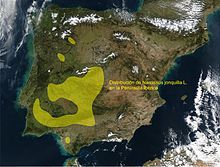| Jonquil or Rush daffodil | |
|---|---|

| |
| Scientific classification | |
| Kingdom: | Plantae |
| Clade: | Tracheophytes |
| Clade: | Angiosperms |
| Clade: | Monocots |
| Order: | Asparagales |
| Family: | Amaryllidaceae |
| Subfamily: | Amaryllidoideae |
| Genus: | Narcissus |
| Species: | N. jonquilla
|
| Binomial name | |
| Narcissus jonquilla | |

| |
| Distribution range on the Iberian Peninsula | |
| Synonyms | |
| |
Narcissus jonquilla, commonly known as jonquil[3] or rush daffodil, is a bulbous flowering plant, a species of the genus Narcissus (daffodil) that is native to Spain and Portugal but has now become naturalised in many other regions: France, Italy, Turkey, the former Yugoslavia, Madeira, British Columbia in Canada, Utah, Illinois, Minnesota, Ohio, and the southeastern United States from Texas to Maryland.
Narcissus jonquilla bears long, narrow, rush-like leaves (hence the name jonquil, Spanish junquillo, from the Latin juncus 'rush').[4][5] In late spring it bears heads of up to five scented yellow or white flowers. It is a parent of numerous varieties within Division 7 of the horticultural classification.[6] Division 7 in the Royal Horticultural Society classification of Narcissus includes N. jonquilla and N. apodanthus hybrids and cultivars that show clear characteristics of those two species.[7][8]
N. jonquilla has been cultivated since the 18th century in France as the strongest of the Narcissus species used in narcissus oil, a component of many modern perfumes.[4]
- ^ Lansdown, R.V.; Caldas, F.B.; Moreno Saiz, J.C. (2017) [errata version of 2017 assessment]. "Narcissus jonquilla". IUCN Red List of Threatened Species. 2017: e.T175237A115717890. doi:10.2305/IUCN.UK.2011-1.RLTS.T175237A7127291.en. Retrieved 20 July 2024.
- ^ The Plant List
- ^ BSBI List 2007 (xls). Botanical Society of Britain and Ireland. Archived from the original (xls) on 2015-06-26. Retrieved 2014-10-17.
- ^ a b Nigel Groom (30 June 1997). The New Perfume Handbook. Springer. pp. 170–171. ISBN 978-0-7514-0403-6. Retrieved 28 July 2012.
- ^ Shorter Oxford English dictionary, 6th ed. United Kingdom: Oxford University Press. 2007. p. 3804. ISBN 978-0199206872.
- ^ RHS A-Z encyclopedia of garden plants. United Kingdom: Dorling Kindersley. 2008. p. 1136. ISBN 978-1405332965.
- ^ Gordon R. Hanks (18 April 2002). Narcissus and Daffodil: The Genus Narcissus. CRC Press. p. 50. ISBN 978-0-415-27344-2. Retrieved 26 July 2012.
- ^ "RHS Plant Selector - Narcissus jonquilla". Archived from the original on 8 April 2014. Retrieved 27 June 2013.
